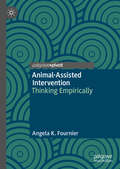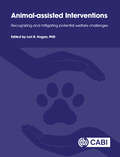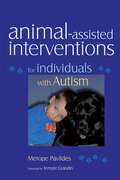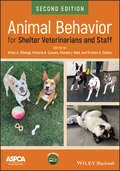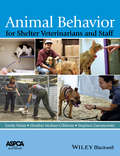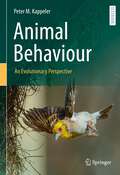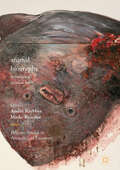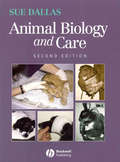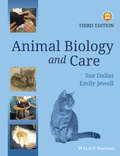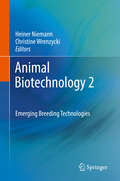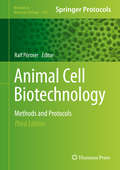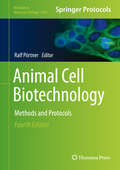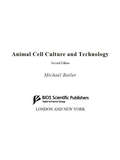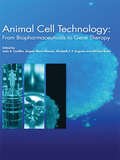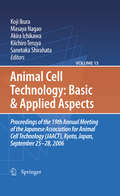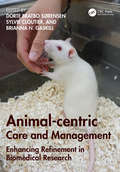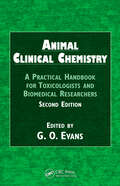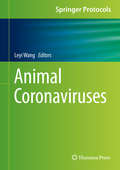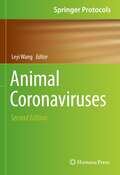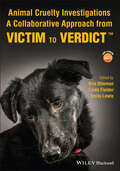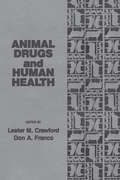- Table View
- List View
Animal-Assisted Intervention: Thinking Empirically
by Angela K. FournierThis book brings the animal into the scholarly discussion of animal-assisted therapy and other interventions. Challenging the current reliance on outcome studies, the author offers a new way of thinking empirically about animal-assisted interventions—analysis of human-animal interaction as a critical component. Through empirical demonstrations from laboratory and applied settings, the book encourages practitioners and scholars to undergo a deeper examination of the basic interactions that occur between clients or patients and therapy animals. Dr. Fournier provides new ideas on measurement, experimentation, and interpretation of human-animal interaction, aimed at identifying the role of the animal in interventions for human health and well-being.
Animal-assisted Interventions: Recognizing and Mitigating Potential Welfare Challenges
by Patti Anderson Nicky Barendrecht-Jenken Anna Van Berg Darlene Blackman Eileen Bona Donna Clarke Linda Chassman Craddock Yvonne Eaton-Stull Aubrey H. Fine Cynnie Foss Angela Fournier Megan French Nina Ekholm Fry Lisa-Maria Glenk Temple Grandin Susan D. Greenbaum Taylor Chastain Griffin Joy R. Hanson Terri Hlava Ann R. Howie Batya Gugenheim Jaffe Amy Johnson Suzanne M. Kapral Jean Kirnan Ursula A. Kohl Veronica Lac Elizabeth A. Letson Helen Lewis Kirsty MacQueen Arieahn Matamonasa-Bennett Angela M. Moe Julie Ann Nettifee Zenithson Ng Brittany Panus Caiti Peters Laura Poleshuck Missy Reed Elizabeth Ruegg Brenda Rynders Sarah Schlote Shira Smilovici Ashley Thompson Risë VanFleet Melissa Y. Winkle Katrina WinsorThis is a practical book exploring how to conduct animal assisted intervention (AAI) in ways that protect and prioritize animal and human welfare. This resource is for social scientists (e.g., psychology, social work, human development and family studies, etc.), as well as ethologists and animal behaviour and welfare students and practitioners. The book is a series of short chapters that depict a wide array of AAIs and their potential welfare concerns. The chapters include descriptions of the AAI offered, the welfare challenges, and ways to successfully mitigate these challenges. This book also covers critical topics including therapy animals' aging, retirement, and death as well as ethical issues including animal consent. Species include not only dogs, but horses, rabbits, and other small animals (e.g., guinea pigs, mice, etc.). Types of AAI involve individual interventions as well as crisis dogs (those who help after natural and man-made disasters), and residential animals. The book is designed to be a practical, engaging book with links to video and examples of real-life situations. It is evidence-based, yet user-friendly and directly applicable to students and practitioners. This highly practical and engaging book with examples of real life situations, videos and case studies, explores how to conduct animal assisted interventions in ways that protect and prioritize animal and human welfare. The book: · Explores how to conduct animal assisted intervention (AAI) in ways that protect and prioritize animal and human welfare. · Discusses potential welfare challenges including how to advocate for the animal, animal consent, and the animal's aging, retirement, or death. · Evidence based approach to mitigating welfare concerns for a wide range of therapy animals including dogs, horses, rabbits, rodents, and exotic animals - and their recipients. An invaluable resource for ethologists and animal behaviour and welfare students and practitioners, as well as social scientists (e.g., psychology, social work, human development and family studies).
Animal-assisted Interventions for Individuals with Autism
by Temple Grandin Merope PavlidesThis book looks at how therapies involving animals can be used to help individuals with autism to develop skills, including sensory and social skills, to manage challenging behaviors, and improve quality of life. Whether participating in therapeutic horseback riding, utilizing a trained service dog, visiting a dolphin therapy center, or simply experiencing companion animal therapy, people with autism can reap a multitude of benefits from interaction with furry, feathered, and finned friends. Merope Pavlides relates the success stories of different animal-assisted interventions, as well as noting the challenges of working with particular animal species. She also emphasizes the importance of tailoring interventions to the specific needs of the individual and of monitoring progress. With recommendations for resources and further reading, this book will be of great interest to people with autism, their parents, and the professionals who work with them.
Animal Behavior for Shelter Veterinarians and Staff
by Brian A. DiGangi Victoria A. Cussen Pamela J. Reid Kristen A. CollinsAnimal Behavior for Shelter Veterinarians and Staff A comprehensive resource to understand the behavioral considerations for intake, management, and rehoming of dogs and cats Animal Behavior for Shelter Veterinarians and Staff provides readers with comprehensive information addressing the behavior of both animals and humans associated with the intake, management, and rehoming of dogs and cats. To aid in practical application, the book covers specific behavior considerations in both dogs and cats. Topics are separated by animal to allow for easy accessibility by professionals who are actively working in the field. Sample topics covered within the book include: The behavior issues that are a common cause of pet relinquishment Behavioral assessment, behavior modification, the integration of behavioral well-being into sheltering Welfare assessment, psychopharmacology, safety net programs, and caring for animals during long-term legal holds Equine care and caring for small mammals Animal Behavior for Shelter Veterinarians and Staff is a must-have reference for evidence-based practical tips, techniques, and protocols for everyday use in animal shelters by shelter volunteers and staff, as well as professional trainers, behaviorists, and veterinarians working with shelters.
Animal Behavior for Shelter Veterinarians and Staff
by Stephen Zawistowski Emily Weiss Heather Mohan-GibbonsAnimal Behavior for Shelter Veterinarians and Staff presents and evaluates the available research and programs that address both animal and human behaviors associated with the intake, management and rehoming of dog and cats. Introductions to dog and cat behavior relevant to any animal professional Reviews behavioral reasons for the relinquishment of dogs and cats Describes intake and assessment protocol, shelter design, training and enrichment programs that reduce stress and enhance behavioral well-being Concepts to improve the adoption process and support the human-animal bond post-adoption
Animal Behaviour: An Evolutionary Perspective
by Peter M. KappelerThis textbook presents all basic principles of animal behaviour in a clear and concise manner and illustrates them with up-to-date examples. Emphasis is placed on behavioural biology as an integrative discipline of organismic biology, focusing on the adaptive value of behaviours that facilitate resource access, predator avoidance and reproductive success and underlie parental care, all within a comprehensive presentation of social complexity. This new textbook provides a rich resource for students (and teachers) from a wide range of life science disciplines.
Animal Biography: Re-framing Animal Lives (Palgrave Studies in Animals and Literature)
by André Krebber Mieke RoscherWhile historiography is dominated by attempts that try to standardize and de-individualize the behavior of animals, history proves to be littered with records of the exceptional lives of unusual animals. This book introduces animal biography as an approach to the re-framing of animals as both objects of knowledge as well as subjects of individual lives. Taking an interdisciplinary perspective and bringing together scholars from, among others, literary, historical and cultural studies, the texts collected in this volume seek to refine animal biography as a research method and framework to studying, capturing, representing and acknowledging animal others as individuals. From Heini Hediger’s biting monitor, Hachikō and Murr to celluloid ape Caesar and the mourning of Topsy’s gruesome death, the authors discuss how animal biographies are discovered and explored through connections with humans that can be traced in archives, ethological fieldwork and novels, and probe the means of constructing animal biographies from taxidermy to film, literature and social media. Thus, they invite deeper conversations with socio-political and cultural contexts that allow animal biographies to provide narratives that reach beyond individual life stories, while experimenting with particular forms of animal biographies that might trigger animal activism and concerns for animal well-being, spur historical interest and enrich the literary imagination.
Animal Biology and Care
by Sue DallasFollowing the success of the first edition, this new edition has been expanded to include more information on small mammals, birds and fish. Intended as a foundation text for those on animal care, nurse auxiliary and veterinary care assistant courses, it introduces essential theoretical background information and clearly outlines the practical skills necessary when embarking on the care of any animal. Designed specifically to meet the requirements of animal care, pre-veterinary nursing auxiliary and care students; Provides basic training in animal biology and care, with particular attention given to those subjects that students find difficult to understand, such as anatomy and physiology; New chapter additions on fish and birds. Clearly and simply laid out, with over 150 illustrations, Animal Biology and Care 2e will be invaluable to all those training or working in animal care.
Animal Biology and Care
by Emily Jewell Sue DallasThe perfect study companion, Animal Biology and Care, 3rd Edition is specifically designed for students on animal care, animal nursing assistant and veterinary care assistant courses. This edition is fully updated with new course content, a refreshed design and colour illustrations throughout. Basic biological theory is introduced with diagrams for visual learners while photographs demonstrate the common practical procedures carried out by animal care assistants. Key features include: New content on exotic species, recognising the increasing number of these animals kept as pets. Extensive coverage of the Animal Welfare Act 2006 and recent advances in animal welfare. Written in line with course curricula, chapter summaries help you to remember key points and learning objectives. A companion website has interactive MCQs to help you test your knowledge. Divided into three main sections covering animal science and genetics, health and husbandry and nursing procedures, this book will help lay the foundations for a successful career in animal care and management!
Animal Biotechnology 1: Reproductive Biotechnologies
by Heiner Niemann Christine WrenzyckiThis two-volume textbook provides a comprehensive overview on the broad field of Animal Biotechnology with a special focus on livestock reproduction and breeding. The reader will be introduced to a variety of state-of-the-art technologies and emerging genetic tools and their applications in animal production. Also, ethics and legal aspects of animal biotechnology will be discussed and new trends and developments in the field will be critically assessed. The two-volume work is a must-have for graduate students, advanced undergraduates and researchers in the field of veterinary medicine, genetics and animal biotechnology.This first volume mainly focuses on artificial insemination, embryo transfer technologies in diverse animal species and cryopreservation of oocytes and embryos.
Animal Biotechnology 2: Emerging Breeding Technologies
by Heiner Niemann Christine WrenzyckiThis two-volume textbook provides a comprehensive overview on the broad field of Animal Biotechnology with a special focus on livestock reproduction and breeding. The reader will be introduced to a variety of state-of-the-art technologies and emerging genetic tools and their applications in animal production. Also, ethics and legal aspects of animal biotechnology will be discussed and new trends and developments in the field will be critically assessed. The two-volume work is a must-have for graduate students, advanced undergraduates and researchers in the field of veterinary medicine, genetics and animal biotechnology.This second volume is dedicated to genetic tools in animal biotechnology such as somatic cloning, transgenic technologies and the application of stem cells in livestock breeding. Also, ethics and legal aspects are discussed.
Animal Breeding and Genetics (Encyclopedia of Sustainability Science and Technology Series)
by Matthew L. SpanglerThis newly updated and revised volume of the Encyclopedia of Sustainability Science and Technology (ESST) details the role of Animal Breeding and Genetics in the sustainability of animal agriculture. The volume covers scientific principles and applications includes the current science used to advance cattle, poultry, swine,sheep, and equine populations, as well as the future role of techniques such as gene editing. International leaders in the field explain foundational concepts such as heritability, the covariance between relatives, statistical approaches to predicting the genetic merit of individuals, and the development and advancement of molecular techniques to elucidate changes in the DNA sequence that underly phenotypic variation. The use of genetic-based tools to improve animal agriculture and meet consumer demands across species is treated in detail. Readers will gain an understanding of how global livestock producers have implemented advanced genetic selection tools and used them to improve reproduction, production, efficiency, health, and sustainability. The interactions of genetics and production environments, and the genetic components of the complex interactions among animals are also discussed. The future of Animal Breeding and Genetics, including the challenges and opportunities that exist in feeding a growing world population, are addressed.
Animal Brucellosis
by Klaus NielsenThis timely publication updates and standardizes currently used diagnostic procedures for this widespread, economically costly livestock disease. It includes state-of-the-art technology, now in limited use, which will replace the conventional methodology in the near future. The volume covers research done on improved diagnostic techniques, vaccines, taxonomy, epidemiology, pathology, and basic immunology. It is an important literature review for those more established in this field and serves as a guide to researchers or diagnosticians becoming involved with this disease.
Animal Cell Biotechnology: Methods and Protocols (Methods in Molecular Biology #1104)
by Ralf PörtnerThe second edition of this book constitutes a comprehensive manual of new techniques for setting up mammalian cell lines for production of biopharmaceuticals, and for optimizing critical parameters for cell culture considering the whole cascade from lab to final production. The chapters are written by world-renowned experts and the volume's five parts reflect the processes required for different stages of production. This book is a compendium of techniques for scientists in both industrial and research laboratories that use mammalian cells for biotechnology purposes.
Animal Cell Biotechnology: Methods and Protocols (Methods in Molecular Biology #2095)
by Ralf PörtnerAnimal Cell Biotechnology: Methods and Protocols, Fourth Edition constitutes a comprehensive manual of state-of-the-art techniques for setting up mammalian cell lines and media for development of biopharmaceuticals, and optimizing critical parameters for cell culture considering the whole cascade from the lab to the final production. Special emphasis was put on model-assisted concepts. Scientists with long-refined expertise describe cutting-edge techniques for the production of therapeutic proteins and vaccines. Capturing the major advances that have occurred in both science and the technology of these biopharmaceuticals, this important book covers the powerful new techniques used in cell line and media development, optimizing process techniques and process strategies, use of model-assisted tools for process design and optimization, and in analysis. Topics include cell line and media development, techniques for process development, model-based techniques for process development, process analysis, and downstream techniques. The volume is divided into five parts that reflect the processes required for different stages of production. Written in the highly successful Methods in Molecular Biology series format, chapters include introductions to their respective topics, lists of the necessary materials and reagents, step-by-step, readily reproducible laboratory protocols, and tips on troubleshooting and avoiding known pitfalls.Animal Cell Biotechnology: Methods and Protocols, Fourth Edition provides a compendium of techniques for scientists in industrial and research laboratories that use mammalian cells for biotechnology purposes.
Animal Cell Culture and Technology (THE BASICS (Garland Science))
by Michael ButlerAnimal cell culture is an important laboratory technique in the biological and medical sciences. It has become an essential tool for the study of most biochemical and physiological processes and the use of large-scale animal cell culture has become increasingly important to the commercial production of specific compounds for the pharmaceutical industry. This book describes the basic requirements for establishing and maintaining cell cultures both in the laboratory and in large-scale operations. Minimal background knowledge of the subject is assumed and therefore it will be a readable introduction to animal cell culture for undergraduates, graduates and experienced researchers. Reflecting the latest developments and trends in the field, the new topics include the latest theory of the biological clock of cell lines, the development of improved serum-free media formulations, the increased understanding of the importance and control of protein glycosylation, and the humanization of antibodies for therapeutic use.
Animal Cell Technology: From Biopharmaceuticals to Gene Therapy
by Leda Castilho Ângela Maria Moraes Elisabeth F. P. Augusto Michael ButlerAnimal Cell Technology: from Biopharmaceuticals to Gene Therapy provides a comprehensive insight into biological and engineering concepts related to mammalian and insect cell technology, as well as an overview of the applications of animal cell technology. Part 1 of the book covers the Fundamentals upon which this technology is based and covers the science underpinning the technology. Part 2 covers the Applications from the production of therapeutic proteins to gene therapy. The authors of the chapters are internationally-recognized in the field of animal cell culture research and have extensive experience in the areas covered in their respective chapters.
Animal Cell Technology: Proceedings of the 19th Annual Meeting of the Japanese Association for Animal Cell Technology (JAACT), Kyoto, Japan, September 25-28, 2006 (Animal Cell Technology: Basic & Applied Aspects #15)
by Koji Ikura Kiichiro Teruya Sanetaka Shirahata Masaya Nagao Akira IchikawaAnimal cell technology is a growing discipline of cell biology which aims not only to understand structures, functions and behaviors of differentiated animal cells, but also to ascertain their abilities to be used for industrial and medical purposes. The goal of animal cell technology includes the clonal expansion of differentiated cells, the optimization of their culture conditions, modulation of their ability to produce proteins of medical and pharmaceutical importantance, and the application of animal cells to gene therapy, artificial organs and the production of functional foods. This volume gives the readers a complete review of the present state-of-the-art and will be useful for those working in either academic environments or in the biotechnology and pharmaceutical sectors, particularly cell biologists, biochemists, molecular biologists, immunologists, biochemical engineers and all other disciplines related to animal cell culture.
Animal-centric Care and Management: Enhancing Refinement in Biomedical Research
by Dorte Bratbo Sørensen, Sylvie Cloutier, and Brianna N. GaskillThe concept of the 3Rs (Refinement, Reduction and Replacement) has been used as a framework for improving the welfare of laboratory animals for the last half century. By establishing an animal-centric view on housing and management, Animal-centric Care and Management: Enhancing Refinement in Biomedical Research takes Russell and Burch’s definition of Refinement as "elimination of inhumanities" and goes further. Rather than fitting animals into experimental conditions, it encourages readers to adjust conditions to better meet the behavioral, emotional, physical, and physiological needs and preferences of the animals. The team of expert authors, from the fields of laboratory animal science, ethology, biology as well as animal training, provide ideas for creating housing conditions and handling procedures that induce, to the best of current abilities and knowledge, a long-term positive state of mind in the animals under our care. This book is written for animal caretakers, animal health technicians, researchers, animal facility managers, laboratory animal veterinarians, and anyone who engages in work with living experimental animals or is interested in the continuous improvement of laboratory animal welfare. This interdisciplinary guide will act as a catalyst, resulting in multiple viewpoints and fields collaborating to optimize laboratory animal welfare.
Animal Clinical Chemistry: A Practical Handbook for Toxicologists and Biomedical Researchers, Second Edition
by G. O. Evans10+ Years of Updates Since First EditionNewcomers to the animal clinical chemistry and toxicology fields quickly find that the same rules of human medicine do not always apply. Following in the footsteps of its standard-setting first edition, Animal Clinical Chemistry: A Practical Handbook for Toxicologists and Biomedical Researchers, Second Editio
Animal Coronaviruses (Springer Protocols Handbooks)
by Leyi WangThis detailed volume provides diagnosticians and researchers with practical methodologies and approaches to tackle animal coronaviruses. It explores conventional immunohistochemistry, virus neutralization, enzyme-linked immunosorbent assays, expression and purification of recombinant viral proteins, and various molecular assays, including conventional and real-time reverse transcription-PCR, reverse genetics methodology, and next generation sequencing and sequence analyses. As part of the Springer Protocols Handbooks series, chapters contain readily reproducible laboratory protocols as well as expert tips on troubleshooting and avoiding known pitfalls. Practical and authoritative, Animal Coronaviruses serves as an ideal reference for researchers examining a wide variety of coronavirus species in the Coronaviridae.
Animal Coronaviruses (Springer Protocols Handbooks)
by Leyi WangThis detailed new edition compiles fully updated practical methodologies and approaches for diagnosticians and researchers working toward a better understanding of animal coronaviruses. The book explores vital techniques in virus isolation, diagnostic approaches via the detection of viral nucleic acids or proteins, serology, disease-targeted animal species models, and next-generation sequencing and bioinformatics. Written for the invaluable Springer Protocols Handbooks series, chapters contain readily reproducible laboratory protocols as well as expert tips on troubleshooting and avoiding known pitfalls. Thorough and hands-on, Animal Coronaviruses, Second Edition will help readers design and carry out their increasingly important projects in clinical research, diagnostics, disease surveillance, and epidemiological study involving this family of viruses.
Animal Cruelty Investigations: A Collaborative Approach from Victim to Verdict
by Kris Otteman Linda Fielder Emily LewisAnimal Cruelty Investigations: A Collaborative Approach from Victim to Verdict provides a framework for the experts who respond to animal cruelty cases: veterinarians, law enforcement agencies, animal care and control organizations, and prosecutors. This book is a practical guide which provides insight and direction for every phase of an animal cruelty investigation. The step-by-step guidance on responding to particular issues and challenges related to animal cruelty cases is bolstered by the extensive library of checklists, form templates, specific case protocols, and lists of available resources. This book is designed to empower readers to respond to animal cruelty cases confidently and effectively by: Introducing veterinarians to their critical role in animal cruelty investigations including forensic examination and necropsy, crime scene response, report writing, and testimony. Included are detailed Specific Case Protocols for common animal cruelty scenarios. Helping animal shelters navigate the challenges of holding animals in protective custody, housing unusual species, and placing evidence animals in foster care. Offering law enforcement agencies useful methods for investigating animal cruelty such as search and seizure protocols, witness interview techniques, and valuable forms and templates necessary to strengthen and ensure proper search warrant execution, evidence collection and handling, and chain of custody; all with a focus on animals as both victims and evidence. Guiding prosecutors through the steps necessary to utilize the veterinarian’s findings during trial and providing insight into issues to be considered when reviewing search warrants, filing charges, proposing plea agreements, or filing pre-conviction forfeiture motions. This book is a must-have reference and guide for veterinarians, technicians, law enforcement officers, prosecutors, and all those involved in the protection of animals’ health and wellbeing. The successful investigation of animal crimes relies on each of these disciplines, not only carrying out their professional duties, but having a collective understanding of what each other needs in order to meet that expectation.
Animal Drugs and Human Health
by Lester M. Crawford Don A. FrancoThe presence of drug and chemical residues in food products from animal sources is both a public health problem and a consumer concern. This is the first book to examine and analyze this problem in a scientific, non-partisan way. The twelve contributing authors are all recognized authorities on this topics. An important resource for food scientists and analysts working with meat food products.
